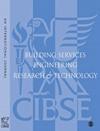Tracking building operational energy and carbon emissions using S-curve trajectories—a prototype tool
IF 1.8
4区 工程技术
Q3 CONSTRUCTION & BUILDING TECHNOLOGY
Building Services Engineering Research & Technology
Pub Date : 2022-12-26
DOI:10.1177/01436244221145392
引用次数: 0
Abstract
New and refurbished non-domestic buildings are failing to live up to their anticipated performance. Shortfalls show in excess energy consumption, high carbon dioxide emissions and other failings in quantitative and qualitative performance metrics. This paper describes the component parts of the performance gap using evidence from building performance evaluations. It introduces a way of visualising the consequences of decisions and actions that are known to compromise performance outcomes using a performance curve methodology (the S-curve) which plots performance, and the root causes of underperformance, from project inception to initial operation and beyond. The paper tests the hypothesis with two case studies. It also covers the initial development of a prototype visualisation tool designed to enable live projects to track emerging operational energy and emissions against a high energy and emissions trajectory created from empirical evidence. The tool aims to help practitioners identify key risk factors that could compromise building performance and mitigate these risks at different stages of procurement. Practical application: The Operational Energy and Carbon (OpEC) visualisation tool is designed for wide industrial application, on all sizes of a non-domestic building project, large and small. It aims to visualise the likely outturn energy performance of a project by calculating the penalties for shortcomings in project delivery. The penalties are visualised as weighted trajectories of energy and carbon dioxide emissions. The prototype tool aims to fill a gap between the capabilities of powerful energy modelling tools used in design and the capacity of non-specialist stakeholders to understand the emerging energy characteristics of a project as it moves through procurement, design, construction, and delivery.使用S曲线轨迹跟踪建筑运营能源和碳排放——一种原型工具
新建和翻新的非住宅楼宇未能达到预期的表现。不足表现在能源消耗过剩、二氧化碳排放量高,以及定量和定性绩效指标方面的其他缺陷。本文使用来自建筑绩效评估的证据来描述绩效差距的组成部分。它引入了一种方法来可视化决策和行动的后果,这些决策和行动已知会损害绩效结果,使用绩效曲线方法(s曲线)来绘制绩效,以及绩效不佳的根本原因,从项目开始到初始运营以及之后。本文通过两个案例研究验证了这一假设。它还涵盖了原型可视化工具的初步开发,旨在使现场项目能够根据经验证据创建的高能量和排放轨迹跟踪新出现的运营能源和排放。该工具旨在帮助从业者识别可能影响建筑性能的关键风险因素,并在采购的不同阶段减轻这些风险。实际应用:操作能源和碳(OpEC)可视化工具是为广泛的工业应用而设计的,适用于各种规模的非住宅建筑项目,无论大小。它的目的是通过计算项目交付中的缺陷的惩罚来可视化项目可能产生的能源绩效。惩罚被可视化为能源和二氧化碳排放的加权轨迹。原型工具旨在填补设计中使用的强大能源建模工具的能力与非专业利益相关者理解项目在采购、设计、施工和交付过程中出现的能源特征之间的空白。
本文章由计算机程序翻译,如有差异,请以英文原文为准。
求助全文
约1分钟内获得全文
求助全文
来源期刊

Building Services Engineering Research & Technology
工程技术-结构与建筑技术
CiteScore
4.30
自引率
5.90%
发文量
38
审稿时长
>12 weeks
期刊介绍:
Building Services Engineering Research & Technology is one of the foremost, international peer reviewed journals that publishes the highest quality original research relevant to today’s Built Environment. Published in conjunction with CIBSE, this impressive journal reports on the latest research providing you with an invaluable guide to recent developments in the field.
 求助内容:
求助内容: 应助结果提醒方式:
应助结果提醒方式:


